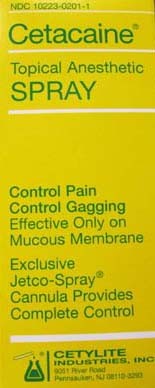Cetacaine Topical Anesthetic
Cetylite Industries Inc.
Cetylite Industries Inc.
Cetacaine Topical Anesthetic
FULL PRESCRIBING INFORMATION: CONTENTS*
FULL PRESCRIBING INFORMATION
Action
Indications
Cetacaine is a topical anesthetic indicated for the production of anesthesia
of all accessible mucous membrane except the eyes. Cetacaine
Spray is indicated for use to control pain or gagging.
Cetacaine in all forms is indicated to control pain and for use for surgical
or endoscopic or other procedures in the ear, nose, mouth, pharynx,
larynx, trachea, bronchi, and esophagus. It may also be used for
vaginal or rectal procedures when feasible.
Dosage and Administration
Cetacaine Spray should be applied for approximately one second or
less for normal anesthesia. Only a limited quantity of Cetacaine is
required for anesthesia. Spray in excess of two seconds is
contraindicated. Average expulsion rate of residue from spray, at normal
temperatures, is 200 mg per second.
To apply, insert the Jetco cannula (J-4) firmly onto the protruding plastic
stem on the bottle and press the cannula forward to actuate the spray
valve. The cannula may be removed and reinserted as many times as
required for cleaning, or sterilization, and is autoclavable.
Cetacaine Liquid Apply 200 mg (approximately 6 – 7 drops or 0.2 cc)
with a cotton applicator or directly to tissue. Do not hold the cotton
applicator in position for extended periods of time, since local reactions
to benzoate topical anesthetics are related to the length of time
of application. Liquid in excess of 400 mg (approx. 12 – 14 drops or
0.4 cc) is contraindicated.
*See Cetacaine Liquid Kit instructions for additional directions for application
by Luer-lock syringe and applicator tip.
Cetacaine Gel Apply 200 mg of gel (a bead approximately 0.5 inch
(13 mm) in length and 3/16 inch (5 mm) in diameter) and spread thinly
and evenly over the application area. Gel in excess of 400 mg (a bead
approximately 1 inch (26 mm) in length and 3/16 inch (5 mm) in diameter)
is contraindicated.
An appropriate pediatric dosage has not been established for Cetacaine
Spray, Liquid or Gel.
Dosages should be reduced in the debilitated elderly, acutely ill, and
very young patients.
Tissue need not be dried prior to application of Cetacaine. Cetacaine
should be applied directly to the site where pain control is required.
Anesthesia is produced within one minute with an approximate
duration of thirty minutes. Each 200 mg dose of Cetacaine (Spray
residue, Liquid or Gel) contains 28 mg of benzocaine, 4 mg of butamben
and 4 mg of tetracaine HCl.
Side Effects
Hypersensitivity Reactions
:
Unpredictable adverse reactions (i.e. hypersensitivity,
including anaphylaxis) are extremely rare.
Localized allergic reactions may occur after prolonged or repeated use
of any aminobenzoate anesthetic. The most common adverse reaction
caused by local anesthetics is contact dermatitis characterized by erythema
and pruritus that may progress to vesiculation and oozing. This
occurs most commonly in patients following prolonged self-medication,
which is contraindicated. If rash, urticaria, edema, or other manifestations
of allergy develop during use, the drug should be discontinued. To minimize
the possibility of a serious allergic reaction, Cetacaine preparations should not
be applied for prolonged periods except under continual supervision. Dehydration
of the epithelium or an escharotic effect may also result from prolonged contact.
Precaution: On rare occasions, methemoglobinemia has been reported
in connection with the use of benzocaine-containing products.
Care should be used not to exceed the maximum recommended
dosage (see Dosage and Administration). If a patient becomes cyanotic, treat appropriately
to counteract (such as with methylene blue, if medically indicated).
Use in Pregnancy
Safe use of Cetacaine has not been established
with respect to possible adverse effects upon fetal development.
Therefore, Cetacaine should not be used during early pregnancy, unless
in the judgment of a physician, the potential benefits outweigh
the unknown hazards. Routine precaution for the use of any topical
anesthetic should be observed when Cetacaine is used.
Cetacaine is not suitable and should never be used for injection. Do
not use on the eyes. To avoid excessive systemic absorption, Cetacaine
should not be applied to large areas of denuded or inflamed tissue.
Cetacaine should not be administered to patients who are
hypersensitive to any of its ingredients or to patients known to have
cholinesterase deficiencies. Tolerance may vary with the status of the
patient.
Cetacaine should not be used under dentures or cotton rolls, as retention
of the active ingredients under a denture or cotton roll could possibly
cause an escharotic effect. Routine precaution for the use of any
topical anesthetic should be observed when using Cetacaine.
How Supplied
Cetacaine Spray contains CFC-114 and CFC-11, substances which
harm public health and environment by destroying ozone in the
upper atmosphere.
RX Only.

Cetacaine Topical AnestheticBenzocaine, Butamben and Tetracaine Hydrochloride Topical Aerosol AEROSOL, SPRAY
| |||||||||||||||||||||||||||||||||||||||||||||||||||||||